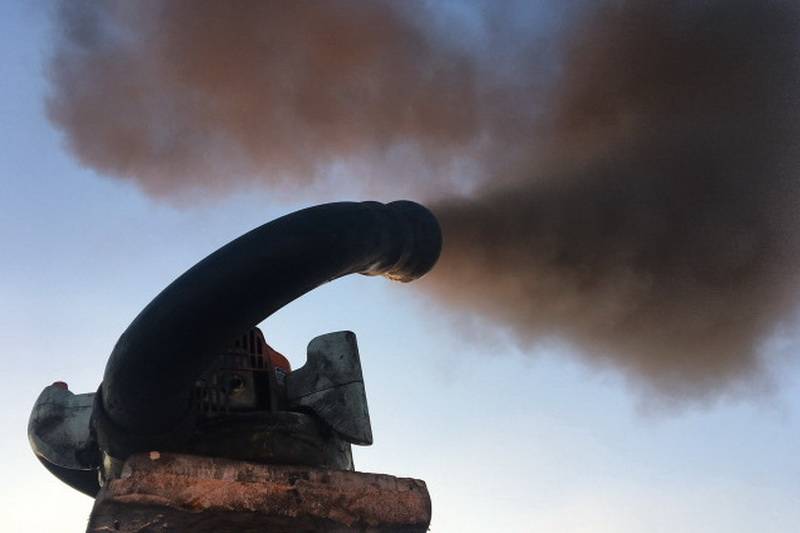Mechanical and manual cleaning
For mechanical cleaning of chimneys, the same tools are used today as 200 years ago. The technology itself has not undergone major changes either. Cleaning is carried out from the side of the roof and from the side of the oven.
Tools and materials
To perform cleaning from the roof side, use:
- rope or steel cable;
- rigid metal brushes and cargo;
It is important that the load has the correct center of gravity. Otherwise, it may get stuck.
It is ideal to use a round metal core as a load. It is to them that the blockage breaks through. And only then the brushes are used.
If you don't have a suitable brush at hand, you can make one yourself from an old plastic bottle. Step by step instructions below.
How to make a ruff with your own hands?
- Take a plastic bottle and cut 150 mm from the top. Make cuts along the upper part in 15 mm increments. The length of the cut is selected depending on the diameter of the pipe. If the pipe diameter is 100 mm, then the brush diameter should be 130 - 140 mm.
- Drill a hole in the center of the plug. Screw the plug into place and bend the petals.
- The first brush is ready. Now we do the second in the same way.
- Find a suitable load. Its weight must be sufficient for the brush to pass through the chimney.
- Tie the load to a strong cord or steel cable. Thread the other end of the cord through the plugs of the brushes. The brushes should be located towards each other.
- Take the rest of the bottle. Cut off the bottom. It turns out a cylinder. Cut it lengthwise. Insert it between the brushes. The length of the cylinder should be about 150 mm. Give it a diameter equal to half the diameter of the brush. Fix with a stapler.
-
Tie a knot over the top brush plug. The tool is ready.
DIY brush making process
There is another option for making a brush with your own hands:
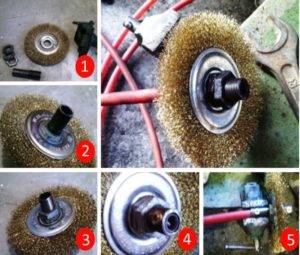
DIY brush in the form of a brush
Cleaning from the roof side
The whole process consists of 6 stages:
- Prevent soot from entering the room. To do this, cover the firebox with a wet cloth and close all hatches.
- Prepare in advance and use all the necessary equipment for the intended purpose, observe all safety requirements when working at height. You will need: safety glasses, closed non-slip shoes, gloves, insurance. It is forbidden to carry out work in rain and strong wind. And also under the influence of drugs, alcohol and other drugs.
- Remove the head, inspect the channel. If necessary, remove debris with a broom.
- The first pass is done with a load. Cleans the chimney from coarse dirt.
- After that, install the brushes and clean the walls of the channel from soot. There is no need to rush. It is not difficult, but a messy and time-consuming process.
- The last step is cleaning the revision chambers.
Chimney cleaning from the stove side
The previous method will allow you to clear the channel only before the first turn. Further, another tool will help to clean the stove from soot without disassembling it. You can't use gravity.
The oven must have special cleaning hatches. To do this, use another tool. An area 3 to 5 m long can be cleaned with a special brush with a tough but flexible fiberglass cable, available at hardware stores.
There is also a more specific tool:

Chimney cleaning tool
Such a device allows you to clean a longer section. The outdoor chimney is the easiest to clean. But only if it is correctly assembled.
Step-by-step instruction:
Unscrew the plug. Clean it from dirt, soot and debris.
If the pipe is made of stainless steel, then the use of a metal brush is strictly prohibited.
We attach a suitable brush and carry out the cleaning, gradually moving the brush upward.
Cleaning from the firebox itself is carried out in a similar way.Flexible but rigid support allows you to push the brush far enough.
The collected soot is removed. And they carry out minor repairs to the chimney
It is important not to forget to replace the pipe head.
Chimney cleaning with folk remedies
So that you do not care about cleaning the chimney, so that the draft does not decrease from deposits, make it a habit to periodically - once a week or so - heat the stove with alder or aspen. This wood has a high burning temperature and contains substances that soften the soot just as well as chemical catalysts. You can periodically add a few alder logs as a preventive measure. There are other means:
- Potato peels, potatoes, or starch. Warm up the stove well, add a few aspen or alder logs to the bookmark, then add potatoes or peelings.
-
If you use potato peels, it is better to take dried ones (when they are dry, but not yet tough).
- Potatoes - small, cut into small pieces.
- Starch (about a kilogram) is poured onto a spatula, poured into the fire.
-
- A pound of salt or soda. Also pour into a well-heated oven - on the second burnt-out bookmark.
- Dried corn cobs.
All these agents soften the soot layer, but only if it is not coked - it is not flooded with condensate and has not compacted.
How to clean a chimney
If problems are identified, you can independently clean the chimneys using both professional and folk methods. To do this, it is enough to use mechanical devices, special chemicals and just household salt or starch. But much here depends on the degree of clogging and the amount of soot inside. Often, with such a cleaning, you have to resort to several methods at once.
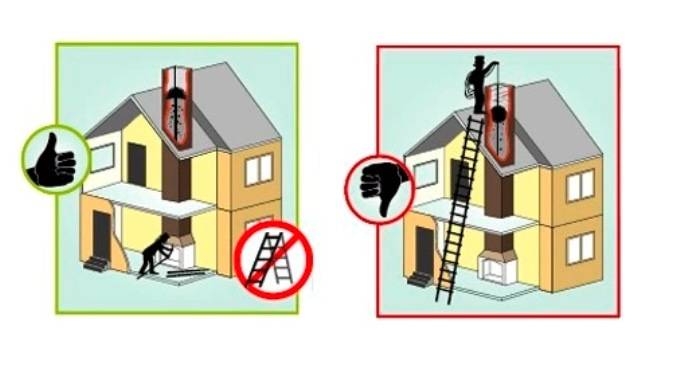
How to properly clean the chimney yourself
Mechanical methods
The most effective way to clean the chimney is mechanical. Chimney sweeps have been using it for centuries, the entire technology of this process has been worked out during this time to the smallest detail. It is possible to clean the chimney by this method both from the bottom of the stove insert (fireplace hearth) and from the top from the roof. But there are nuances.
From above, this method will only be able to clean the vertical section of the chimney duct.
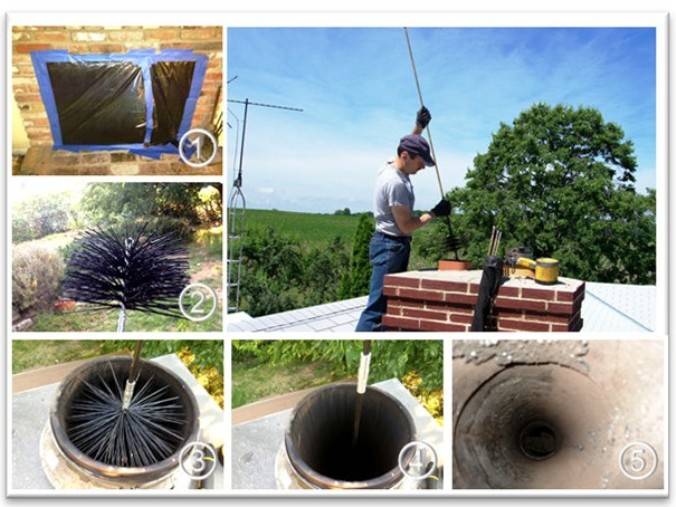
How to clean a chimney with a telescopic brush
Places of pipe turns should be cleaned from soot from inside the house through the firebox or special doors (holes) in the masonry of the stove.
As a tool for mechanical cleaning, the following is used:
- Ruff on a stick or rope with a sinker at the bottom.
- Ruff on a flexible cable (similar analogs are used by plumbers).
- Metal scraper for particularly stubborn soot stains.

How to clean the chimney from below

How to make a plastic bottle chimney brush
Chemical methods
If you don't want to try on the role of a chimney sweep on the roof, then you can use specialized chemistry. Now there are a lot of products based on copper chloride and ammonium sulfate with phosphorus oxide. At first glance, how to choose an air conditioner for an apartment, it is difficult to understand the range of such chemicals. But everything is quite simple - it is allowed to take any option.

How chemical chimney cleaning works
These chemicals, when burned, emit smoke, which travels up the pipe and looses the soot, causing it to fall down. Then you just need to collect it with a scoop from the bends of the chimney and the stove or fireplace.
Similar chemistry is produced in the form of powders in bags and logs-briquettes. The main nuance of their use is the need for thorough ventilation of the home during cleaning and immediately after.

Chimney cleaners
To clean the chimney with these means is as easy as shelling pears, threw them into the furnace and that's it.However, when they burn, they emit unpleasant and harmful components, which are definitely not worth breathing.
Folk ways to clean the chimney
You can also clean the chimneys of fireplaces, gas boilers and coal-wood stoves using:
- table salt (half a kilo for kindling);
- dry potato peels and just chopped potatoes (a few kilograms at a time);
- powdered naphthalene (apply to logs, gives off a pungent odor);
- aspen firewood.
The principle of operation here is simple - vapors of sodium chloride (salt), starch (from potatoes) and naphthalene corrode the soot, carrying it along with the smoke up into the street or forcing it to fall down. With dry aspen, the situation is somewhat different, this wood burns with the highest temperature among all other options for firewood. The dusty soot on the walls of the chimney simply burns out from this heat.
Why clean your chimney and stove?
Soot deposits form in the oven and on the walls of the chimney. Gradually, the draft becomes too weak and it is no longer possible to operate the stove normally. Waste gets into the room, which is very dangerous.
Soot and dust are the main causes of fire. Fire often starts in the chimney. Combustion products get through the cracks onto the wooden floor structures. This is how it goes.

Soot inside the chimney
The chimney can also get clogged from the top. Especially if the pipe is not covered with a deflector. In summer, birds or wasps can easily build nests there.
An increased soot content in the flue gas duct can be the result of errors in the construction of the stove. Somewhere the pipe narrows, somewhere an extra turn. The slightest mistake intensifies the formation of soot in such places.
To remove all combustion products and other debris from the chimney and you need to carry out regular cleaning. This will avoid the narrowing of the flue gas duct and avoid a fire.
Simple cleansing methods
A layer of soot on the thick walls of the chimney affects the quality of the furnace itself and safety. Heavy waste accumulates inside, can get into living rooms, and soot particles deposited on the chimney can be flammable and provoke an accident. All this can be avoided if you clean the chimney near the stove in a timely manner, you can do this at home on your own.
The easiest method to clean your chimney is with traditional table salt. These manipulations are of a preventive nature, because they will not help to clean a thick burnt layer, but they can remove fresh layers of soot and soot. With regular use of this simple technique, carbon deposits reappear over a longer period.
The essence of this simple method is as follows: you need to add a handful of kitchen salt to dry firewood. At the moment of combustion, it is she who is able to influence the chemical processes taking place inside the furnace, as a result, soot does not settle on the pipe walls so quickly and intensively. This method of how to clean a pipe is most effective only if it is not yet completely clogged with a layer of soot.
The second risky method of cleaning the oven passage is to completely burn off any existing deposits on the pipe walls. It is done with an emphasis on the chemical composition of soot in stove flues. The whole point is that the oily compounds deposited on the walls of the furnaces are not completely burned out heavy chemicals that have not been processed due to a lack of oxygen. Therefore, if you heat the firebox to the required temperature, then the soot inside burns out on its own, without the need for additional manipulations.
In order for the soot to warm up properly, it is necessary to put a significant amount of firewood, such as dry alder or aspen.The stove must be thoroughly melted, after which you need to open all the available blowers, after which a large armful of dry firewood is sent to the firebox.
The risk of this method, how to clean a pipe, is that not every home stove is able to withstand the high temperature test. At the time of such a risky burn, it is worth very carefully monitoring all the sparks that come out through the open chimney in the stove. A similar cleaning procedure must be carried out until white flakes of smoke begin to be produced by the stove. When a characteristic hum appears, this is a signal to stop such an emergency furnace.
Another method of pipe cleaning with folk remedies is to use simple potato peels, which usually go to the garbage chute. It consists in the fact that the released starch actively interacts with the accumulated soot, effectively breaking it down. Such raw materials will be required in the amount of half or a whole bucket, here the consumption depends on the dimensions of the furnace itself. Also, instead of such peelings, you can put fresh whole potatoes if the final quality is not satisfactory.

We recommend that you familiarize yourself
How to clean chimneys in a stove with folk remedies
In the fight against soot deposits, very affordable chimney cleaners that are in every home can be of great help.
Rock salt
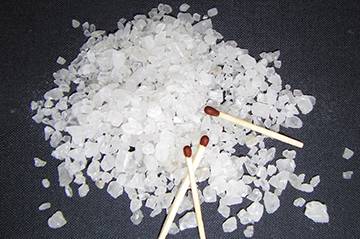 Rock salt is a very popular prophylactic agent, due to which less soot sticks to the pipe walls.
Rock salt is a very popular prophylactic agent, due to which less soot sticks to the pipe walls.
The use of salt is very simple: you need to sprinkle it on the fuel tab before lighting.
This method is quite effective and inexpensive.
Raw potatoes or potato peels
This product is useful if soot has already been deposited on the inner surface of the chimney. The amount of finely chopped potatoes should be from 0.5 to a whole bucket, lay a little more peelings.
The agent is laid out on the still burning fuel immediately after intensive heating of the furnace. The steam generated as a result of its combustion loosens the soot deposits and forces it to lag behind the pipe walls.
A certain amount of soot may crumble at the same time, but it is not worth expecting that the pipe is completely cleaned: treatment with potato steam is used mainly to facilitate subsequent mechanical cleaning.
Aspen firewood
With a few armfuls of such fuel, you can get rid of the soot pretty quickly. Due to the intensive firing of the aspen furnace, the temperature in the chimney rises significantly and the black "fur coat" flares up.
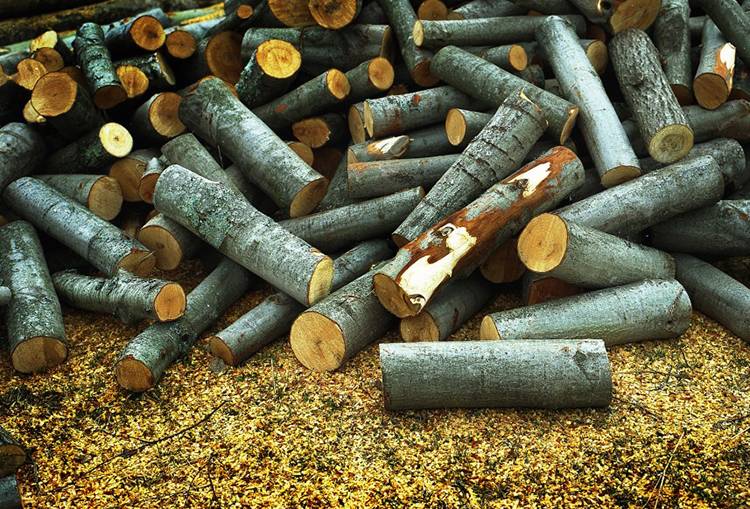
Aspen firewood
However, it should be borne in mind that burning off soot is a rather dangerous method of cleaning a chimney from the point of view of fire safety.
In addition, the result of this action is the release of a large amount of white flakes, abundantly covering the roof and the area adjacent to the house.
Pipe cleaning with aspen should only be used if there is complete confidence that the structure will withstand the elevated temperature.
If the soot layer is particularly thick, this method is best avoided altogether.
Professional chimney cleaning: fast, reliable and expensive
Strange as it sounds, the profession of a chimney sweep exists and is still appreciated all over the world. It will be interesting for you to know that the traditional chimney sweep cylinder has always been the privilege of only the master. And to become such, it was necessary to serve as an apprentice for more than one year - this specialty is so difficult.
In recent years, the profession of a chimney sweep has been on the verge of extinction, and only relatively recently has it become sharply in demand. It's all about fires due to poor-quality installation of chimneys and their operation.A modern house is so expensive today that it is wiser to hire a specialist than to rely on "maybe". Indeed, it is much more logical to call a professional chimney sweep before the start of the heating season, and not a fire engine in the middle of winter.
For a long time, the All-Russian Voluntary Fire Society was engaged in cleaning the chimney, but today such services are already offered more by private companies. After all, the correct operation of modern chimneys requires periodic revisions, cleaning and prevention. So there was such a thing as professional chimney cleaning, when special equipment is brought for such a purpose. For example, a special vacuum cleaner that simply sucks soot out of the chimney through the firebox. And then you do not need to drag it through the entire room (and the soot is volatile and is poorly washed from furniture).
Therefore, to this day, professional cleaning simply cannot be done in the most advanced cases, when:
- the chimney is covered with a dense layer of solid soot (especially from wet firewood);
- chimney walls are old and damaged, and soot clings tightly to them;
- you do not have the slightest desire to do such a dirty job.
In practice, it looks like this:
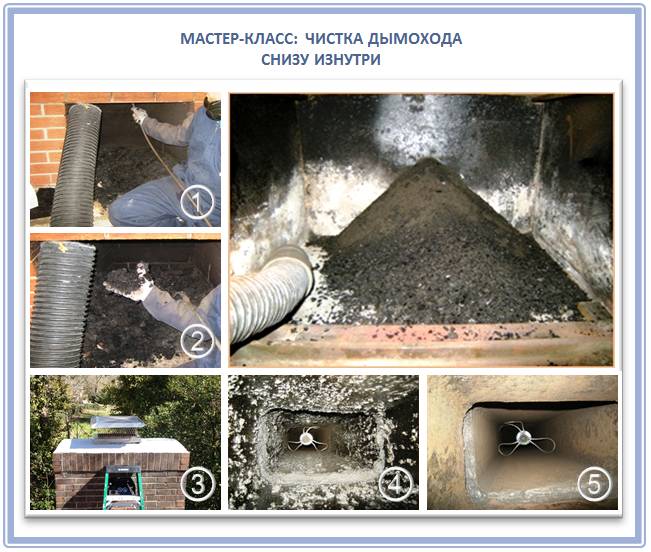
For example, in the professional cleaning of chimneys of private houses, the following special devices are used:
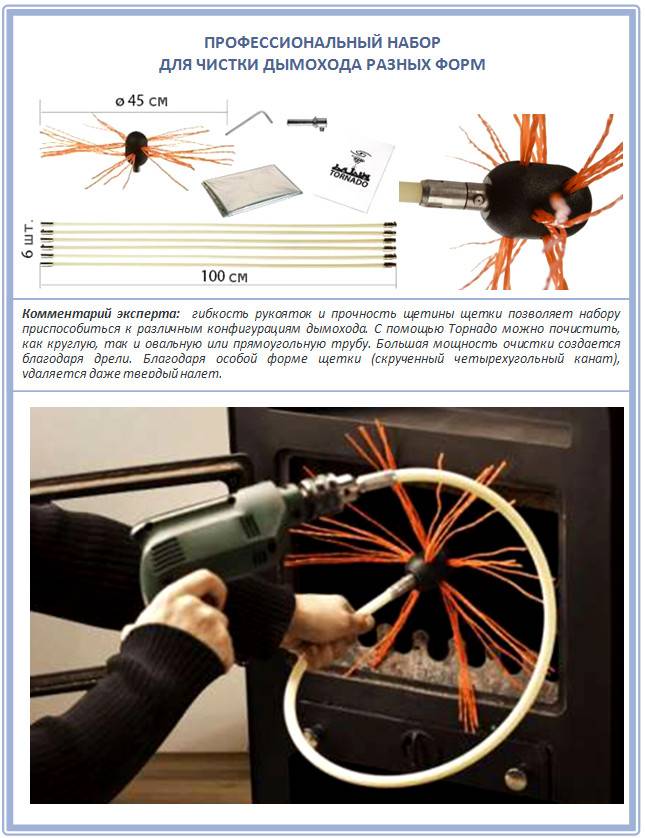

Modern high-speed installations, which completely clean the chimney in just an hour, cope with their task quickly enough:

When to clean the chimney

Firewood must lie for at least a year and a half before consumption.
The first signal of a stove (fireplace) chimney clogging is dark smoke from combustion products. If hardwood firewood or pellets are used, the smoke is clear, sometimes white. Darkening indicates the accumulation of soot, carbon deposits and dirt. The second sign is that the wood does not make noise during burning, the flame becomes dark orange. When these signs appear, it's time to think about calling a chimney sweep or get ready for cleaning yourself.
But, before you clean the chimney yourself, it is still better to first inspect the pipe.
Stove-maker's note: in any chimney at the bottom there must be a cleaning pocket through which dirt and debris is removed.
A cleaning weight with a diameter corresponding to the size of the chimney should be in every home. If it easily passes into the pipe, then the reason for the poor performance of the stove is in something else. If the weight stops in one place, then the chimney is clogged and the duties of a chimney sweep cannot be avoided.

The most ancient folk way is to put raw potato peelings (or chopped raw potatoes) into a heated oven.
When they burn, starch is released, which softens soot deposits. One part of the deposits flies out through the pipe, the other falls into the stove (fireplace). To prevent the formation of soot deposits, you can also burn rock salt at the same time with firewood.
The most reliable, but also dangerous method is to put a good heap of aspen logs into a heated stove without closing the door. The stove will begin to hum, the soot will ignite, and a flame will appear from the chimney. This method can be used if the chimney is really very reliable.
Determining the cleaning time
Over time, deposits will form on pipes made of any material. It must be cleaned, otherwise the chimney will not work efficiently. When clogged, a back draft effect is formed and smoke enters the room, and not to the street. This can also lead to failure of the oven.
When choosing a cleaning time, you need to pay attention to the following factors:
- Downtime. When was the last cleaning done, in what way.
- Chimney design. How can the pipes be cleaned. The smoothness of the walls is also taken into account.
- What kind of fuel is used.Was raw wood used for the firebox? Have plastic and other rubbish been thrown into the stove?
There are a number of signs by which one can understand that it is necessary to clean chimneys and chimneys from soot.
- Change in smoke color. With a clean chimney, almost transparent smoke comes out into the street. If it begins to blacken, soot has accumulated in the pipe, which must be removed.
- Changing the color of the fire in the furnace. Under normal conditions, it should be light orange, and the wood should crackle characteristically. If an orange color appears, the chimney should be cleaned.
The simplest and most reliable way is a preventive check of the chimney by specialists. For this they use special weights that are placed in the pipe. If they easily pass to the oven, there is no precipitation or they are minimal. In the event of obstructions, urgent cleaning is required.
Signs of a clogged chimney
When the flue gas duct becomes clogged, it will be immediately visible. The main signs of a clogged channel will be the following phenomena:
- Decreased traction in the stove or fireplace. It is necessary to check the gate, and if it is in the open position, it means that the cleaning of the pipe is overdue.
- The gradual attenuation of the flame in the furnace of the heating unit.
- Difficult fuel ignition. If you use dry wood and they don't burn, then the chimney is most likely to blame.
- Changing the color of the flame in the furnace. You should especially be on your guard if it has acquired an orange blossom.
- Strong unpleasant odor. If corrosive smoke appears in the room during the heating process, it means that carbon monoxide (carbon monoxide) gets into it. In this case, the room must be well ventilated, the firebox must be interrupted and measures must be taken to clean the chimney.
What to do if the chimney is clogged
Before the start of the heating season, it is imperative to inspect the inside of the chimney for blockages. In the warm season, birds with a nest can settle in it, or garbage can appear, blown into the chimney by the wind. To avoid this, the chimney should be equipped with a head with a mesh at the installation stage to prevent such situations.
In such a case, the house should always have a backup heating unit in the form of an air heater or an electric heater built into the heating system.
Having provided yourself with heat with its help in the cold season, you can thoroughly consider the situation and think over options for getting out of it.
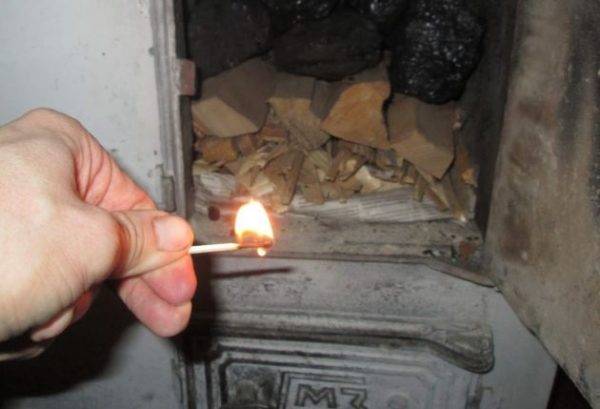 The presence of a draft in the firebox must be checked every time the stove is fired - the flame must deflect towards the chimney
The presence of a draft in the firebox must be checked every time the stove is fired - the flame must deflect towards the chimney
Loaded brush
Chimney cleaning with various mechanical devices has been known for a long time. It was this method that was imprinted on the folklore of many European countries. Monuments to chimney sweeps can be found not only in the west, but even in Russia.
Which once again speaks of the importance of their work. However, we will not be distracted from the main goal, namely, from the answer to the question of how you can clean the chimney.
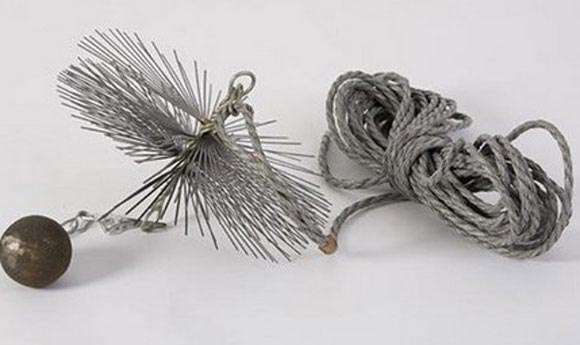
For pipes with a circular cross-section, a ruff is best suited. This is a disc-shaped metal brush that is suspended from a cable or rope. A load is attached to the bottom of the brush - a core or a spherical weight. Other items can also act as a load.
But here it is important to remember that only objects with a stable and unbiased center of gravity should be used. Otherwise, such a load can get stuck in the pipe and then the problem can be solved only by completely disassembling the chimney. ... Gravity pulls the brush down the pipe
A rope is used for lifting. The core itself (without a brush) can be used to break through tight blockages and plugs. Thanks to the carabiner connections, the brush elements can be quickly disconnected and assembled in the desired sequence
Under the influence of gravity, the brush moves down the pipe. A rope is used for lifting. The core itself (without a brush) can be used to break through tight blockages and plugs. Thanks to the carabiner connections, the brush elements can be quickly disconnected and assembled in the desired sequence
How to reduce soot build-up
Soot and carbon deposits are deposited even in the tubes of gas-fired ovens. What can we say about the combustion of solid fuel - for him this is an even more natural process. At the same time, the amount of combustion products deposited on the walls of the chimney can be significantly reduced. To do this, you should adhere to a few simple rules:
- No rubbish. Do not burn plastic, foam, rubber and other substances with a high carbon content in the firebox of a solid fuel stove.
- Prepare firewood in advance. Remember that quality dry wood burns with virtually no residue, with minimal soot and sludge-causing substances. Among other things, this is facilitated by a higher combustion temperature, which affects the course of pyrolysis processes. As for raw firewood, when used in excess, water vapor is released, as well as substances such as tar, creosote, etc. - they simply do not have time to burn due to the low temperature. Subsequently, all these tar-like substances fall out in the form of a hard-to-remove plaque on the gas duct channels and are the reason for the rapid overgrowth of the channels with soot - it sticks to the sticky substance much more readily.
- Use hardwood. Anyone who fires a stove on their own knows that the best are oak, hornbeam, beech, aspen and acacia firewood. In second place is the wood of walnut, apple, cherry, larch, poplar, sycamore, etc. But firewood from coniferous trees (spruce, pine, juniper, etc.) contains a lot of resins, so when using them, you will need to clean the stove significantly more often. As, however, and when burning birch logs, which are characterized by a high content of tar. By the way, fuel briquettes or pellet pellets that are fashionable today are also subject to careful revision at the time of purchase. If they are made from pine sawdust or sunflower husks, then it is better to bypass such fuel due to the high content of resins and oily substances.
- Make sure that the wood burns optimally. This corresponds to a flue gas temperature of 150 to 350 degrees. With a reduced heat generation, the carbon of the wood does not have time to burn in the furnace and flies away with smoke, simultaneously falling out in the vertical and horizontal channels of the furnace.
In order to achieve the most complete combustion of wood, follow the advice of an experienced stove-maker. Here's what they recommend:
- before putting firewood in the oven, keep it indoors for at least 2-3 days. During this time, they will dry out and warm up to room temperature, which means that they will not only burn better, but also will not require additional waste of heat for preliminary heating;
- before laying the main batch of wood, warm up the combustion chamber by burning chips, pieces of cardboard, etc. in it;
- as the wood burns out, regulate the combustion process with a gate or blower door. Of course, the high temperature in the firebox is good because less soot is formed, but at the same time, the heat will not have time to accumulate in the body of the furnace, and will simply fly away into the atmosphere;
- install a combustion indicator on the chimney. With its help, you can more accurately monitor the temperature of the smoke and keep the heat generation process within optimal limits.

A temperature indicator installed on the chimney will allow you to maintain combustion within optimal limits
Symptoms of an overgrown chimney cannot be overlooked. First of all, the color of the smoke changes. If the flue duct is clean, it will be light, transparent or white. The accumulated soot starts to burn, which changes the color of the smoke. It becomes denser and darker. The hue of the flame in the oven can also change.Under normal conditions, it will be light orange. If a rich shade of dark orange appears, then it's time to think about how to clean the chimney.
In any case, even if there are no warning signs, experts recommend revising the flue gas duct at least twice a year. It should be borne in mind that cleaning may be necessary not only in the case of an increase in the layer of soot, but also from debris, bird's nests, cobwebs, etc. There are many cleaning methods and you can choose the optimal one only after determining the level of pollution, revising the state of the chimney, etc.
Manual mechanical cleaning
The mechanical method of cleaning soot, soot, also refers to the folk. For a long time, kernels were used, fixed with a strong cable, piercing dense growths, ruffs of various shapes, scrapers. This option for removing deposits is a proven, effective method.
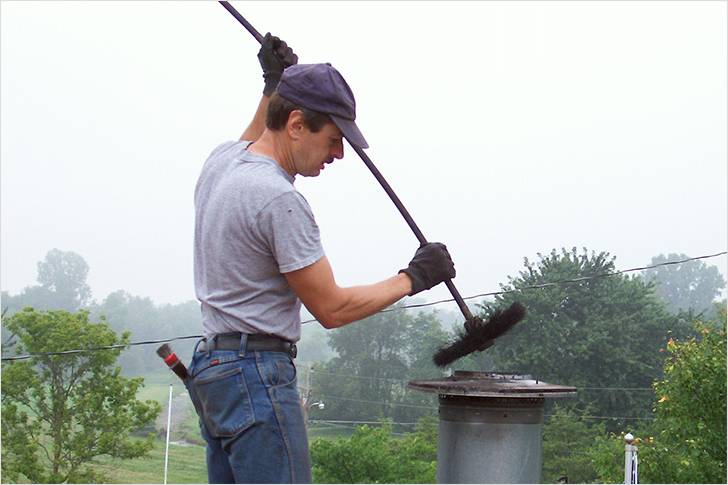
Mechanical cleaning of the chimney is carried out as follows:
Close all oven doors tightly to prevent soot from falling out. When working with fireplace systems, place a damp cloth on top of the combustion compartment.
Open all dampers by increasing the cross-section of the channels.
Climb onto the roof with the safety harness secured to your body.
Examine the flue duct. Soot, which has a layer of about 2 mm, is removed by chemical compounds. If there is debris, push through it.
Clean the chimney - remove the cap, and using a scraper, a stiff brush, remove layers.
Keep hard-to-reach pipe areas clean with a flexible brush. It is advisable to use a cable equipped with a nozzle. Move the fixture by gently turning the handle.
With the help of a suspended core, the chimney is cleared of serious blockages and soot
Move the steel ball by moving.
Be careful to keep the brick intact.
Remove soot by opening the smoke duct doors.
Clean the combustion and blower compartments. Open fireplaces are treated from the side of the firebox with a metal brush with a long handle.
After completing the work, melt the stove, check the efficiency of the draft. Mount the head, it is easy to install.
Professional chimney cleaning
Specialized equipment will clean the chimney with high quality and quickly enough. Specialists perform work in two ways - vacuum method and Tornado installation.
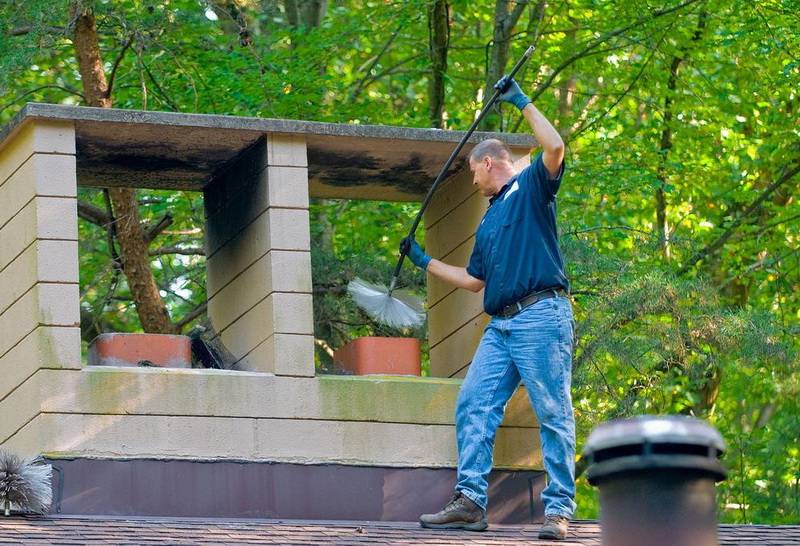
Vacuum cleaning
The appliance nozzle is placed inside the chimney. A powerful motor that is running creates a sufficiently strong directional air flow. The method of operation of the unit is similar to that of a vacuum cleaner.

The accumulation of soot is thrown out of the pipe under high pressure. This method cleans quickly and efficiently, but has disadvantages. The first of them is the high price of the installation itself - from 30 thousand rubles. Buying it for use at home is not profitable. The second, rather strong minus soot, flies far out of the pipe, settling in the neighboring area, thereby causing the discontent of others.
